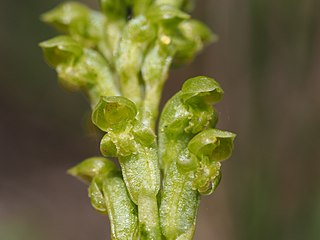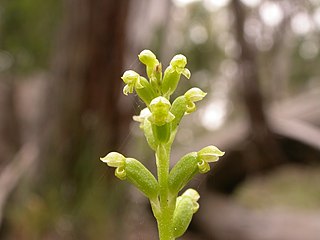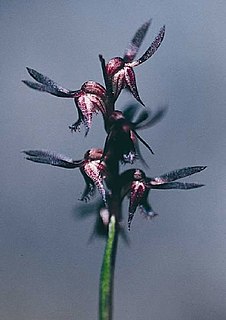
Microtis, commonly known as onion orchids or mignonette orchids is a genus of about 20 species of plants in the orchid family, Orchidaceae. Onion orchids are terrestrial herbs with a single leaf at the base of the plant. They are similar to orchids in the genus Prasophyllum in that they have an onion-like leaf. The flowers are small but often scented and attractive to their insect pollinators. They are widespread in Asia, Australia and some Pacific islands.

Microtis unifolia, commonly known as the common onion orchid, is a species of orchid occurring from south China to Japan, Malesia, and Australasia to the Southwest Pacific. It has a single green leaf and up to one hundred small green or yellowish-green flowers. A common, widespread orchid which is easily grown in pots and is sometimes a weed in plant nurseries.

Microtis parviflora, commonly known as the slender onion-orchid, is a species of orchid which is native to Australia and New Zealand. It occurs in all states of Australia but is not known from the Northern Territory and may not occur in Western Australia. As with others in the genus, it has a single erect, smooth, tubular leaf and up to eighty flowers on an erect flower spike.

Genoplesium rhyoliticum, commonly known as the Pambula midge-orchid or rhyolite midge orchid and as Corunastylis rhyolitica in Australia, is a species of orchid endemic to New South Wales. It is a small orchid with up to eighteen dark, purplish-black flowers and is only known from six sites on the south coast where it grows in shallow soil over rhyolite.
Microtis alba, commonly known as the white mignonette orchid or slender onion-orchid, is a species of orchid endemic to the south-west of Western Australia. It has a single hollow, onion-like leaf and up to sixty small, green and white flowers with a strong musky fragrance. It is much more common after a fire the previous summer than in unburned country.

Microtis arenaria, commonly known as the notched onion orchid, is a species of orchid endemic to south-eastern Australia. It has a single hollow, onion-like leaf and up to sixty scented, crowded yellowish-green flowers. It is widespread and common, growing in a wide variety of habitats.
Microtis atrata, commonly known as the swamp mignonette orchid or yellow onion orchid and sometimes as Microtidium atratum, is a species of orchid endemic to southern Australia. It has a single thin leaf and up to forty or more yellowish-green flowers. The flowers are the smallest of any Australian ground-dwelling orchid. The orchid usually grows in large colonies after fire and although small, are easily seen because of their very large numbers in their blackened surroundings.
Microtis brownii, commonly known as the sweet mignonette orchid or sweet onion orchid, is a species of orchid endemic to the south-west of Western Australia. It has a single hollow, onion-like leaf and up to sixty small, green and white scented flowers well-spaced along the flowering stem. It usually grows in swampy places, flowers more prolifically after summer fires and sometimes forms very large colonies.
Microtis cupularis, commonly known as the cupped mignonette orchid sometimes as Hydrorchis cupularis, is a species of orchid endemic to the south-west of Western Australia. It has a single thin, hollow, onion-like leaf and up to thirty small, yellowish-green and red flowers. The plants often grow in shallow water and are self-pollinating.
Microtis quadrata, commonly known as the south coast mignonette orchid or south coast onion orchid, is a species of orchid endemic to south-west coastal areas of Western Australia. It has a single thin, hollow, onion-like leaf and up to one hundred small, pale green flowers. This onion orchid grows on low mounds in swamps, often with other species of mignonette orchids, and flowers much more prolifically after fire.
Microtis eremaea, commonly known as the slender mignonette orchid or inland onion orchid is a species of orchid endemic to the south-west of Western Australia and western South Australia. It has a single thin, hollow, onion-like leaf and up to fifty small greenish-yellow flowers. The flowers have a distinctive heart-shaped labellum and the orchid generally grows in more inland areas than most other onion orchids.
Microtis eremicola, commonly known as the desert mignonette orchid or dryland onion orchid, is a species of orchid endemic to the south-west of Western Australia. It has a single hollow, onion-like leaf and up to fifty small, dull green to greenish-yellow flowers. This onion orchid is common in soil pockets on granite outcrops in inland areas, mostly between Hyden and Balladonia.
Microtis familiaris, commonly known as the coastal mignonette orchid or coastal onion orchid is a species of orchid endemic to the south-west coastal region of Western Australia. It has a single hollow, onion-like leaf and up to twenty small, green to greenish-yellow, sweetly scented, widely spaced flowers. It often grows with large populations of other Microtis orchids but only flowers after fire.
Microtis globula, commonly known as the globular mignonette orchid or globular onion orchid is a species of orchid endemic to the south-west coastal region of Western Australia. It has a single hollow, onion-like leaf and up to thirty five small greenish-yellow, almost globe-shaped flowers. It often grows in large colonies but only flowers after hot fires the previous summer.

Microtis oblonga, commonly known as the sweet onion orchid, is a species of orchid endemic to south-eastern Australia. It has a single hollow, onion-like leaf and up to fifty scented, bright green flowers. It is considered by some Australian authorities to be synonymous with Microtis rara.
Microtis rara, commonly known as the scented onion orchid, is a species of orchid endemic to Australia, with the exception of the Northern Territory. It has a single hollow, onion-like leaf and up to fifty small green or yellowish-green, scented flowers. It is similar to Microtis oblonga and some authorities regard the two as being one species.
Microtis graniticola, commonly known as the granite mignonette orchid or granite onion orchid is a species of orchid endemic to the south-west of Western Australia. It has a single thin, hollow, onion-like leaf and up to sixty small green to greenish-yellow flowers. It grows in soil pockets on granite outcrops, especially where the soil receives run-off during rainy weather.

Microtis orbicularis, commonly known as the dark mignonette orchid, is a species of orchid endemic to southern Australia. It has a single thin, more or less hollow, onion-like leaf and up to fifty small yellowish-green and red flowers. The plants grow in winter-wet areas, often in shallow water and unlike the similar M. cupularis do not turn black as they dry.
Microtis pulchella, commonly known as the beautiful mignonette orchid or beautiful onion orchid, is a species of orchid endemic to the south-west of Western Australia. It has a single hollow, onion-like leaf and up to twenty five white, thinly textured flowers with a slight perfume. It only flowers after fire and only sometimes produces short, thread-like leaves in the absence of fire.
Microtis oligantha, commonly known as the small onion orchid is a species of orchid endemic to New Zealand. It has a single thin, hollow, onion-like leaf and up to ten small green flowers. It differs from the other two onion orchids in New Zealand, in being a much smaller plant with a more pointed dorsal sepal.







